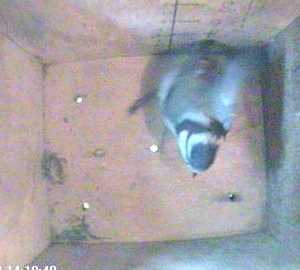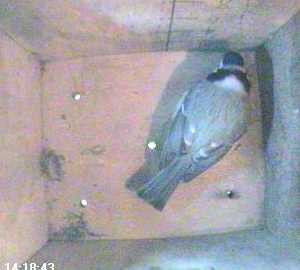

We've been arguing again about the nest selection roles of the male and female bluetit. Tradition has it that the male finds a likely spot and leads the female to it. If she likes it, then that's it - this is the nesting place for this year's nest.
We have had various excitements since we wrote about our early visitor last autumn. First, Elizabeth ruptured the Achilles tendon in her left foot which meant an operation to have it sown back together again.
Then, shortly before Christmas, Malcolm noticed that something didn't look right about Box2 - the one in the front of our garden. On examining more closely, it was clear that the old birch tree it was attached to was leaning about 15° to the vertical, its branches entangled with those of the oak tree next to it. In fact, if it wasn't for the oak tree, the birch with the nest box and its video camera would have fallen to the ground, no doubt breaking the cabling if nothing else in the process. Clearly, a new home must be found for this box - and quickly. Spring is not too far away!
Our very sporadic updates last November also ended because the visitor to Box1 stopped visiting. For the last few days she has been back. In fact, if we get a sunny day she seems to be in and out every few minutes. She doesn't roost overnight though.
You can see her comings and goings by looking at Box1 on the Web Viewer in the table at the top of this page. If you want to look at the history file, select Box1 and click on Playback.
Here's a couple of images to start the new season. Nothing unusual here you might say. However...


We've been arguing again about the nest selection roles of the male and female bluetit. Tradition has it that the male finds a likely spot and leads the female to it. If she likes it, then that's it - this is the nesting place for this year's nest.
The trouble is that it difficult to check this out as the two sexes look so alike. Behaviour is a much clearer guide to a bluetit's sex than is any differences in plumage. However, at this stage, when looking at the birds inside the nest, there aren't any of the usual behavioral clues - like nesting wriggles, only done by the female. Or one bird feeding the other - only one bird goes into the nest at a time.
In previous years we have noticed two differences in plumage that help to tell male from female. First, the white band around the head of a female is thinner that of the male. And the head feathers of the male are a darker blue and more masculine (ie rougher and a bit tousled). But at this time of year, neither of these differences are clear enough when looking at the birds one at a time.
Which brings us (at last!) to the pictures above. These were taken of the same bird 3 seconds apart. Has this bird got a broad or a narrow head band? Ie is it male or female? Very frustrating.
Today the rotten birch has been removed. This tree, to which the nest box was attached, was on the boundary of and just inside our neighbour's garden. When Elizabeth went out this morning, she noticed a hive of activity and the sound of sawing. By midday the tree was no more and was being cut up for logs.
Looking at the stump, it is surprising that it survived as long as it did. It shows a large rotten hole surrounded by a thin layer of dead wood. The stump, shown on the left, shows that the tree was about 2 ft in diameter before it fell, but that most of this was hole!
No wonder we have found lots of stag beetles near this spot each year.